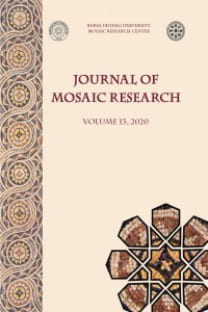Elipsler, Yastıklar ve Çanlar. -Çoğunlukla- Kuzey Afrika Mozaiklerinde Yer Alan Bir Familya
Bu makalenin amacı, İS 2. yüzyıldan 4. yüzyıla kadar uzanan dönemde, özellikle Kuzey Afrika’da (17 döşeme üzerinde 24) ve özellikle Tunus’ta (14 döşemede) iyi temsil edilen bir geometrik mozaik familyasını karakterize etmektir. Bu mozaiklerin ortak özelliği genelde mozaikler üzerinde çok sık rastlanmayan üç şekli, yani “elips”, “yastık” ve “çan”ı içermeleridir. Bu “elipslerin” aslında Roma amfi tiyatrolarının yapımında kullanılanlara benzer ovaller olduğu varsayılmaktadır. Mevcut durumda, bunlar bir kare içinde yer almaktadır, çoğu zaman aynı işlemi izleyerek gerçekleştirilir ve uygulanması oldukça kolaydır (23 döşeme). Bu döşemelerin genel deseni, bir şerit kafesi üzerine kuruludur, ovaller kafesin daha büyük karelerine işlenmiştir. Yastıkları ve çanları betimleyen diğer daire yayları da bu kafesle yakın ilişki içinde yürütülür. Göreceli değişkenliğin önemli bir unsuru, iki tür bandın genişlikleri arasındaki orandır, böylece çanlar ve minderler ve dolayısıyla ilgili iç dekorları için daha fazla veya daha az yer bırakır.
Anahtar Kelimeler:
Kuzey Afrika, şerit kafesi, elips, yastık, çan
Ellipses, Cushions and Bells. A Family of -Mostly- North African Mosaic Pavements
The purpose of this article is to characterize a family of geometric mosaic decors which are especially well represented in North Africa (17 pavements on 24) and especially in Tunisia (14 pavements), extending from the second to the fourth century AD. Their common feature is to include three shapes not very frequently found in mosaic, namely the so-called “ellipse”, “cushion” and “bell”. We assume that these “ellipses” are in fact ovals, similar to those used for building the Roman amphitheaters. In the present case they are inscribed in a square and most often carried out following a same process, quite easy to implement (23 pavements). The general pattern of these pavements is set on a grid of bands, the ovals being inscribed in the larger squares of the grid. The other arcs of circles, delineating the cushions and bells, are also carried out in close relationship with this grid. A major element of −relative− variability is the ratio between the widths of the two sorts of bands, thus leaving more space or less for the bells and cushions, and consequently for their respective inner decors.
Keywords:
North Africa, Grid of bands, Ellipse, Cushion, Bell,
___
- Balmelle et al. 1999 C. Balmelle - M. Blanchard-Lemée - J.-P. Darmon - H. Lavagne, « Nouveaux apports à la connaissance de la mosaïque gallo-romaine », CMGR VII, 627-637.
- Blake 1936 M. E. Blake, “Roman Mosaics of the Second Century in Italy”, MemAmAc XIII, 67-214.
- Blazquez – Mezquiriz 1985 J. M. Blazquez - M. A. Mezquiriz, Mosaicos romanos de Navarra, Madrid.
- Corpus Tunisie II/1 M. A. Alexander – A. Ben Abed (coll. S. Besrour-Ben Mansour, D. Soren et alii), Corpus des Mosaïques de Tunisie, II/1, Thuburbo Majus, Tunis, 1980-1994 (4 vol.).
- Corpus Tunisie III, 1 C. Duliére - H. Slim (coll. M. A. Alexander - S. Otrow - J. G. Pedley, D. Soren), Corpus des mosaïques de Tunisie, III, El Jem, 1, Tunis, 1996.
- Corpus Tunisie IV, 1 A. Ben Abed - M. Alexander et alii, Corpus des mosaïques de Tunisie, IV, Carthage, 1, Tunis, 2000.
- Décor I C. Balmelle - M. Blanchard Lemée - J. Christophe - J.-P. Darmon - A.-M. Guimier Sorbets - H. Lavagne - R. Prudhomme - H. Stern, Le Décor géométrique de la mosaïque romaine I, Paris, 1985.
- Décor II C. Balmelle - M. Blanchard-Lemée - J.- P. Darmon - S. Gozlan - M. P. Raynaud, Le Décor géométrique de la mosaïque romaine II, Paris, 2002.
- Dunbabin 1978 K. M. D. Dunbabin, The Mosaics of Roman North Africa, Oxford.
- Golvin 2008 J.-C. Golvin, « L’architecture romaine et ses créateurs, in Rome », Le Point (HS), 92-101.
- Grazian 2017 A. Grazian. « Disegni inediti di pavimenti antichi da Villa Casali sul Celio », AISCOM 22, 413-424.
- Hoffmann et al. 1999 P. Hoffmann - J. Hupe - K. Goethert, Römische Mosaik aus Trier, Trier.
- Parzysz 2008 B. Parzysz, « Des ellipses… sans ellipses: les amphithéâtres romains », Bulletin de l’Association des Professeurs de Mathématiques de l’Enseignement Public 479, 772-780.
- Parzysz 2009 B. Parzysz, “B. Key diagrams to design and construct Roman geometric mosaics?”, Nexus Network Journal 11-2, 273-288.
- Parzysz 2012a B. Parzysz, “Une grande famille de décors géométriques”, M. Şahin (ed.), 11th International Colloquium on Ancient Mosaics, Bursa, 735-748.
- Parzysz 2012b B. Parzysz, « La géométrie de la mosaïque de Penthée (Nîmes) », Bulletin de l’Association des Professeurs de Mathématiques de l’Enseignement Public 500, 420-428.
- Picard 1968 G. C. Picard, « Les thermes du Thiase marin à Acholla », AntAfr 2, 95-151.
- Salies 1974 G. Salies, Untersuchungen zu den geometrischen Gliederungsschemata römischer Mosaiken, Kevelaer.
- Stern 1979 H. Stern, Recueil des mosaïques de la Gaule. Volume I, Gaule Belgique, Paris.
- Thouvenot 1948 R. Thouvenot, « La maison aux Travaux d’Hercule », Publications du Service des Antiquités du Maroc, fascicule 8, 69-108.
- Yacoub 1995 M. Yacoub, Splendeurs des mosaïques de Tunisie, Tunis.
- ISSN: 1309-047X
- Başlangıç: 2008
- Yayıncı: Ululdağ Üniversitesi, Mozaik Araştırlmaları Merkezi
Sayıdaki Diğer Makaleler
Antakya Mevsimler Mozaiğinin Arkeometrik Yönden İncelenmesi
PATARA LİMAN CADDESİNDE MOZAİKLİ BİR YAPI
Roma Mozaiklerinde Mevsim Hayvanları
Zeugma’daki Poseidon Evi Emblemasından Skyros’taki Akhilleus: Caracalla ve Görüntülerin Gücü
Claudiopolis Ganymedes Mozaiği
İsrail‘deki Ḥorbat Ḥadat Kilisesi’nin Mozaik Zeminleri
Ayanis Örnekleri Işığında Urartu Anıtsal Mimarisinde Süsleme Elemanı Olarak Taş Halkalar
Ayşegül AKIN ARAS, Mehmet IŞIKLI
Sergio GARCÍA-DILS DE LA VEGA, Salvador ORDÓÑEZ AGULLA
Bulgaristan’dan Geç Antik Mozaik Döşemelerinde Krismonlar ve Haçlar
